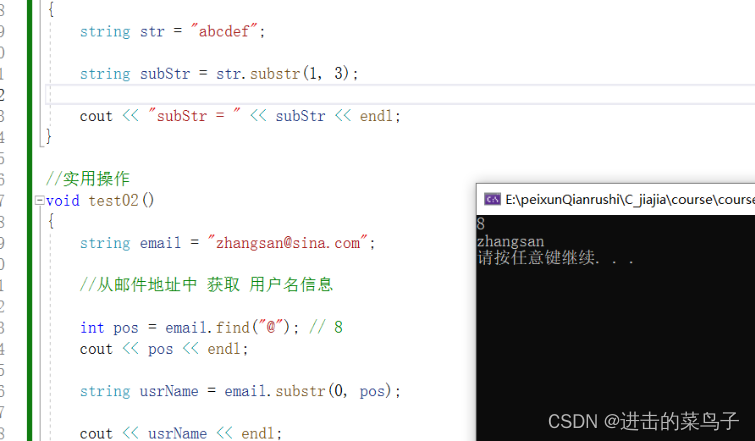string容器
1. string基本概念
1.1 本质:
string是C++风格的字符串,而string本质上是一个类
string和char * 区别:
char * 是一个指针
string是一个类,类内部封装了char*,管理这个字符串,是一个char*型的容器。
1.2 特点:
string 类内部封装了很多成员方法
例如:查找find,拷贝copy,删除delete 替换replace,插入insert
string管理char*所分配的内存,不用担心复制越界和取值越界等,由类内部进行负责
2. string构造函数
构造函数原型:
string(); //创建一个空的字符串 例如: string str;
string(const char* s); //使用字符串s初始化
string(const string& str); //使用一个string对象初始化另一个string对象
string(int n, char c); //使用n个字符c初始化
示例:
string_main.cpp
#include <iostream>
#include <string>
using namespace std;
//string的构造函数
void test() {
string s1; //创建空字符串,调用无参构造函数
cout << "str1 = " << s1 << endl;
const char* str = "hello world";
string s2(str); //把c_string转换成了string
cout << "s2 = " << s2 << endl;
string s3(s2); //调用拷贝构造函数
cout << "s3 = " << s3 << endl;
string s4(10, 'a');
cout << "s4 = " << s4 << endl;
}
int main()
{
test();
return 0;
}
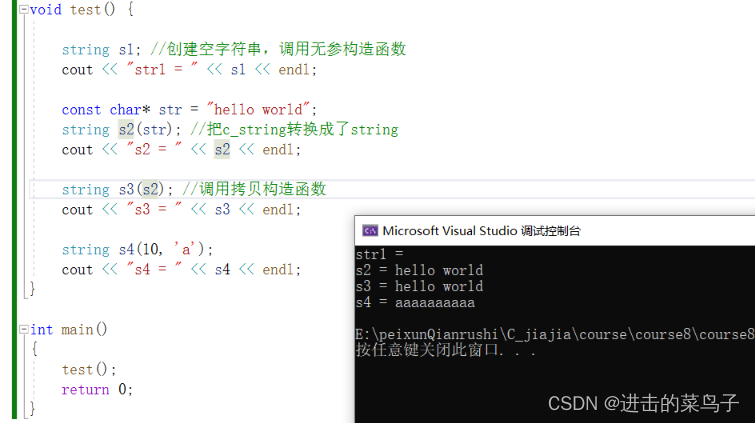
3. string赋值操作
功能描述:
给string字符串进行赋值
赋值的函数原型:
string& operator=(const char* s); //char*类型字符串 赋值给当前的字符串
string& operator=(const string &s); //把字符串s赋给当前的字符串
string& operator=(char c); //字符赋值给当前的字符串
string& assign(const char *s); //把字符串s赋给当前的字符串
string& assign(const char *s, int n); //把字符串s的前n个字符赋给当前的字符串
string& assign(const string &s); //把字符串s赋给当前字符串
string& assign(int n, char c)
总结:
string的赋值方式很多, operator= 这种方式是比较实用的
实例
string_main2.cpp
#include <iostream>
#include <string>
using namespace std;
//string赋值操作
void test() {
string str1;
str1 = "hello world";
cout << "str1 = " << str1 << endl;
string str2;
str2 = str1;
cout << "str2 = " << str2 << endl;
string str3;
str3 = 'a';
cout << "str3 = " << str3 << endl;
string str4;
str4.assign("hello C++");
cout << "str4 = " << str4 << endl;
string str5;
str5.assign("hello C++", 5);
cout << "str5 = " << str5 << endl;
string str6;
str6.assign(str5);
cout << "str6 = " << str6 << endl;
string str7;
str7.assign(10, 'w');
cout << "str7 = " << str7 << endl;
}
int main()
{
test();
return 0;
}
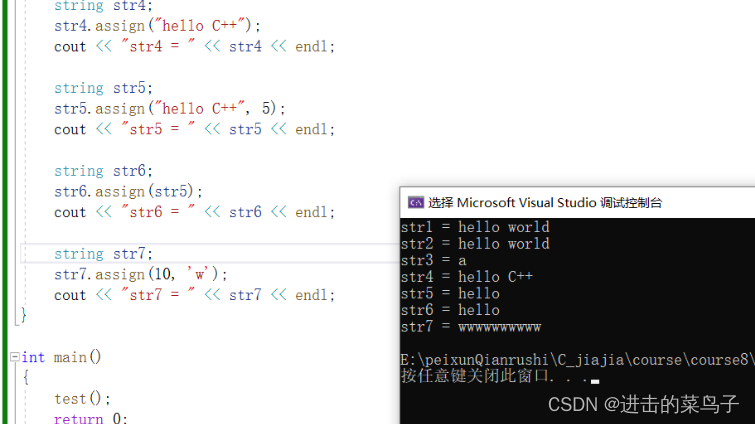
4. string字符串拼接
功能描述:
实现在字符串末尾拼接字符串
函数原型:
string& operator+=(const char* str); //重载+=操作符
string& operator+=(const char c); //重载+=操作符
string& operator+=(const string& str); //重载+=操作符
string& append(const char *s); //把字符串s连接到当前字符串结尾
string& append(const char *s, int n); //把字符串s的前n个字符连接到当前字符串结尾
string& append(const string &s); //同operator+=(const string& str)
string& append(const string &s, int pos, int n); //字符串s中从pos开始的n个字符连接到字符串结尾
示例
string_main3.cpp
#include <iostream>
#include <string>
using namespace std;
//string字符串的拼接
void test01() {
string str1 = "我";
str1 += "爱玩游戏";
cout << "str1 = " << str1 << endl;
str1 += ':';
cout << "str1 = " << str1 << endl;
string str2 = "LOL DNF";
str1 += str2;
cout << "str1 = " << str1 << endl;
string str3 = "I";
str3.append(" love ");
cout << "str3 = " << str3 << endl;
str3.append("game abcde", 4);
// I love game
cout << "str3 = " << str3 << endl;
//str3.append(str2);
//str3.append(str2, 0, 3); //只截取到LOL
str3.append(str2,4,3); // 只截取 DNF, 参数2 从哪个位置开始截取,参数3 截取字符个数
// I love game LOL DNF
cout << "str3 = " << str3 << endl;
}
int main()
{
test01();
return 0;
}
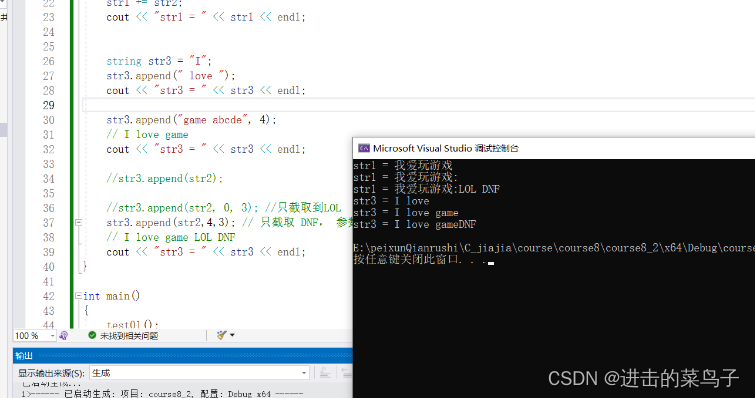
5. string查找和替换
功能描述:
查找:查找指定字符串是否存在
替换:在指定的位置替换字符串
函数原型:
int find(const string& str, int pos = 0) const; //查找str第一次出现位置,从pos开始查找
int find(const char* s, int pos = 0) const; //查找s第一次出现位置,从pos开始查找
int find(const char* s, int pos, int n) const; //从pos位置查找s的前n个字符第一次位置
int find(const char c, int pos = 0) const; //查找字符c第一次出现位置
int rfind(const string& str, int pos = npos) const; //查找str最后一次位置,从pos开始查找
int rfind(const char* s, int pos = npos) const; //查找s最后一次出现位置,从pos开始查找
int rfind(const char* s, int pos, int n) const; //从pos查找s的前n个字符最后一次位置
int rfind(const char c, int pos = 0) const; //查找字符c最后一次出现位置
string& replace(int pos, int n, const string& str); //替换从pos开始n个字符为字符串str
string& replace(int pos, int n,const char* s); //替换从pos开始的n个字符为字符串s
总结:
find查找是从左往后,rfind从右往左
find找到字符串后返回查找的第一个字符位置,找不到返回-1
replace在替换时,要指定从哪个位置起,多少个字符,替换成什么样的字符串
示例
string4_main.cpp
#include <iostream>
#include <string>
using namespace std;
//查找
void test() {
string str1 = "abcdefg";
int pos = str1.find("de");
if (pos == -1) {
cout << "未找到字符串" << endl;
}
else {
cout << "找到字符串,pos=" << pos << endl;
}
//rfind和find
//rfind从右往左查找,find从左往右查找
pos = str1.rfind("de");
cout << "pos=" << pos << endl;
}
//替换
void test02() {
string str2 = "abcdefg";
//从1号位置起 3个字符替换为“1111”
str2.replace(1,3,"1111");
cout << "str2=" << str2 << endl;
}
//string查找和替换
int main()
{
test();
test02();
return 0;
}

6. string字符串比较
功能描述:
字符串之间的比较
比较方式:
字符串比较是按字符的ASCII码进行对比
= 返回 0
> 返回 1
< 返回 -1
函数原型:
int compare(const string &s) const; //与字符串s比较
int compare(const char *s) const; //与字符串s比较
总结:字符串对比主要是用于比较两个字符串是否相等,判断谁大谁小的意义并不是很大
示例
string_main5.cpp
#include<iostream>
using namespace std;
//字符串比较
void test01()
{
string str1 = "hello";
string str2 = "xello";
if (str1.compare(str2) == 0)
{
cout << "str1 等于 str2" << endl;
}
else if (str1.compare(str2) > 0)
{
cout << "str1 大于 str2" << endl;
}
else
{
cout << "str1 小于 str2" << endl;
}
}
int main() {
test01();
system("pause");
return 0;
}

7. string字符存取
string中单个字符存取方式有两种
char& operator[](int n); //通过[]方式取字符
char& at(int n); //通过at方法获取字符
总结:string字符串中单个字符存取有两种方式,利用 [ ] 或 at
示例
string_main6.cpp
#include<iostream>
using namespace std;
#include <string>
//string 字符存取
void test01()
{
string str = "hello";
//cout << "str = " << str << endl;
//1、通过 []访问单个字符
for (int i = 0; i < str.size(); i++)
{
cout << str[i] << " ";
}
cout << endl;
//2、通过at方式访问单个字符
for (int i = 0; i < str.size(); i++)
{
cout << str.at(i) << " ";
}
cout << endl;
//修改单个字符
str[0] = 'x';
// xello
cout << "str = " << str << endl;
str.at(1) = 'x';
// xxllo
cout << "str = " << str << endl;
}
int main() {
test01();
system("pause");
return 0;
}

8. string插入和删除
功能描述:
对string字符串进行插入和删除字符操作
函数原型:
string& insert(int pos, const char* s); //插入字符串
string& insert(int pos, const string& str); //插入字符串
string& insert(int pos, int n, char c); //在指定位置插入n个字符c
string& erase(int pos, int n = npos); //删除从Pos开始的n个字符
总结:插入和删除的起始下标都是从0开始
示例:
string_main7.cpp
#include<iostream>
using namespace std;
#include <string>
//字符串 插入和删除
void test01()
{
string str = "hello";
//插入
str.insert(1, "111");
//h111ello
cout << "str = " << str << endl;
//删除
str.erase(1, 3);
cout << "str = " << str << endl;
}
int main() {
test01();
system("pause");
return 0;
}
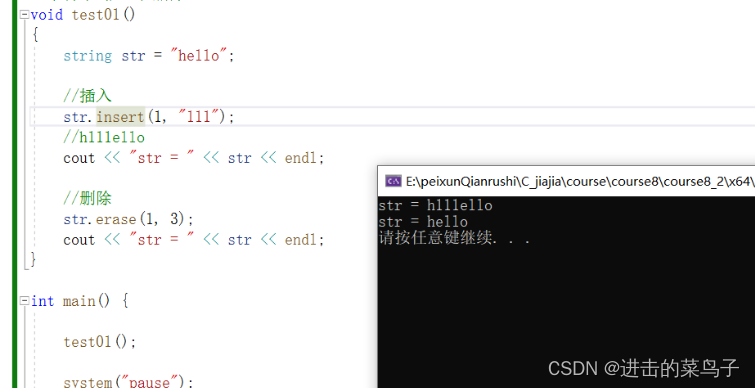
9. string子串
功能描述:
从字符串中获取想要的子串
函数原型:
string substr(int pos = 0, int n = npos) const; //返回由pos开始的n个字符组成的字符串
总结:灵活的运用求子串功能,可以在实际开发中获取有效的信息
示例
string_main8.cpp
#include<iostream>
using namespace std;
#include <string>
//string求子串
void test01()
{
string str = "abcdef";
string subStr = str.substr(1, 3);
cout << "subStr = " << subStr << endl;
}
//实用操作
void test02()
{
string email = "zhangsan@sina.com";
//从邮件地址中 获取 用户名信息
int pos = email.find("@"); // 8
cout << pos << endl;
string usrName = email.substr(0, pos);
cout << usrName << endl;
}
int main() {
//test01();
test02();
system("pause");
return 0;
}
